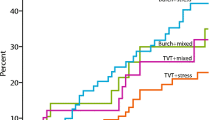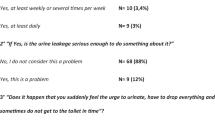Abstract
Introduction and hypothesis
The purpose of the study was to determine the intraoperative and immediate postoperative complications of tension-free vaginal tapes (TVTs) and risk factors contributing to these.
Methods
The study was a retrospective cohort study of 778 TVT procedures.
Results
The intraoperative and postoperative complications from the study are as follows: Intraoperative complications included bladder perforation (6.6%), blood loss requiring transfusion (0.6%), and laparotomy (0.1%). Postoperatively, 3.1% of patients developed UTI, while 56.0% had difficulty voiding, and 16.6% had retention. Upon discharge, 54.8% of patients voided, 34.3% self-catheterized, and 8.0% had indwelling catheters. Surgeons responsible for more than 100 TVT procedures had one third the odds of a bladder perforation. Previous incontinence or prolapse surgery were risk factors for bladder perforation. Women with voiding dysfunction preoperatively had a 1.80-fold odds of difficulty postoperatively.
Conclusion
Bladder perforation and postoperative retention are the most common complications of TVTs. Risk factors for perforation include less frequent TVT performance and previous prolapse, or incontinence surgery. Preexisting voiding dysfunction leads to postoperative retention.
Similar content being viewed by others
References
Minassian VA, Drutz HP, Al-Badr A (2003) Urinary incontinence as a worldwide problem. Int J Gynecol Obstet 82:327–338
Abrams P, Cardozo L, Fall M, Griffiths D, Rosier P, Ulmsten U et al (2002) The standardization of terminology of lower urinary tract function. Report from the Standardization Subcommittee of the International Continence Society. Neurourol Urodynam 21:167–178
Petros P, Von Konsky B (1999) Anchoring the midurethra restores the bladder-neck anatomy and continence. Lancet 354:997–998
Ulmsten U, Petros P (1995) Intravaginal slingplasty (IVS): an ambulatory surgical procedure for treatment of female urinary incontinence. Scand J Urol Nephrol 29:75–82
Aboussaly R, Steinberg J, Lemieux M, Marois C, Gilchrist L, Bourque J-L et al (2004) Complications of tension-free vaginal tape surgery: a multi-institutional review. BJU Int 94:110–113
Schraffordt Koops S, Bisseling T, Heintz A, Vervest H (2005) Prospective analysis of complications of tension-free vaginal tape from The Netherlands Tension-free Vaginal Tape study. AJOG 193:45–52
Cetinel B, Demirkesen O, Onal B, Akkus E, Alan C, Can G (2004) Are there any factors predicting the cure and complication rates of tension-free vaginal tape? Int Urogynecol J 15:188–193
Kuuva N, Nilsson G (2002) A nationwide analysis of complications associated with the tension-free vaginal tape (TVT) procedure. Acta Obstet Gynecol Scand 81:72–77
Meschia M, Pifarotti P, Bernasconi F, Guercio E, Maffiolini M, Magatti F et al (2001) Tension-free vaginal tape: analysis of outcomes and complications in 404 stress incontinent women. Int Urogynecol J Pelvic Floor Dysfunct 12(suppl 2):S24–S27
Al-Badr A, Ross S, Soroka D, Minassian V, Karahalios A, Drutz H (2003) Voiding patterns and urodynamics after a tension-free vaginal tape procedure. JOGC 25(9):725–730
Ross S, Robert M, Swaby C, Dederer L, Lier D, Tang S et al (2009) Transobturator tape compared with tension-free vaginal tape for stress incontinence. Obstetrics and Gynecology 114(6):1287–1294
Acknowledgements
We would like to thank Ruth Griffeth and Monica Hess of Health Information Reporting for creating a list of charts to be reviewed in the study.
Funding
This project was provided by the Adult Research Committee of the Calgary Health Region.
Conflicts of interest
Dr. Sue Ross has received funding for Cook Surgical, Johnson and Johnson, Boston Scientific, the Alberta Heritage Foundation for Medical Research and the Canadian Institutes for Health Research. Ingrid Kristensen and Maysoon Eldoma received funding for the project from the Calgary Centre for Advancement of Health. Tyler Williamson has received funding from the Alberta Heritage Foundation for Medical Research. Dr. Mainprize and Dr. Wood have no financial interest/affiliation to declare.
Author information
Authors and Affiliations
Corresponding author
Rights and permissions
About this article
Cite this article
Kristensen, I., Eldoma, M., Williamson, T. et al. Complications of the tension-free vaginal tape procedure for stress urinary incontinence. Int Urogynecol J 21, 1353–1357 (2010). https://doi.org/10.1007/s00192-010-1210-5
Received:
Accepted:
Published:
Issue Date:
DOI: https://doi.org/10.1007/s00192-010-1210-5




